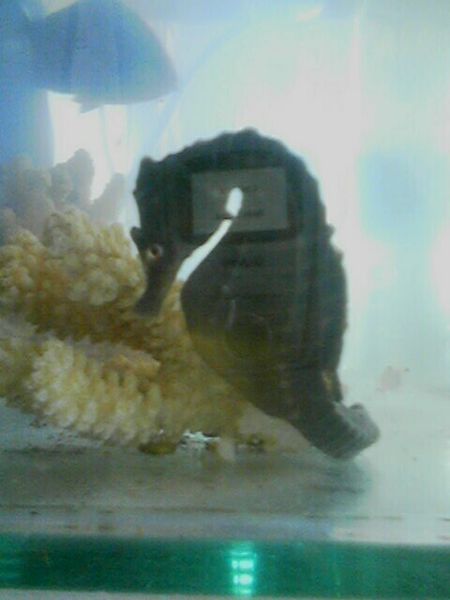Introduction
Today I would like to discuss a large, temperate water seahorse that can be kept and even bred in captivity by those willing to devote the necessary time and effort to its care.
Note: Please see my article posted on this blog on June 27, 2008 for information concerning new research into the phenomenon of “male pregnancy” in seahorses.
A Temperate Seahorse
Most people consider seahorses to be tropical in origin, and may be surprised to learn that the Atlantic seahorse ranges as far north as Nova Scotia, the waters of which are decidedly “un-tropical”. It also occurs south to Venezuela, and it is the only seahorse to dwell north of North Carolina along our eastern seaboard.
Found from the shoreline to depths of over 230 feet, this weak swimmer somehow manages to survive in areas of strong tidal activity. I have collected Atlantic seahorses attached to clumps of marine algae being swept along by very strong currents. Mated pairs are believed to establish stable territories, but I cannot imagine how they can accomplish this in the turbulent waters they sometimes inhabit. I imagine that individuals in such populations move to quiet bays during the breeding season – any information you might have concerning this would be most appreciated.
Feeding Atlantic Seahorses
The Atlantic seahorse’s rather large size, to 7.3 inches, allows it to take a wide variety of prey, including small shrimps, blackworms and fish fry. This, coupled with the fact that many individuals can be tempted to eat frozen foods moved about in a life-like manner, makes the Atlantic seahorse a good (but still delicate) candidate for experienced aquarists.
In addition to the foods mentioned above, Atlantic seahorses that I have kept were extremely fond of amphipods (scuds or side-swimmers), sand hoppers, seed shrimp and sand shrimp that I seined in local marine waters. Their reactions to these food items were quite intense, much more so than to the fish fry, brine shrimp and opossum shrimp (Mysids) that made up the bulk of their diet.
I urge anyone attempting to keep seahorses to collect live foods whenever possible. It is especially advantageous to maintain native species, as you have a better chance of providing these with a balanced diet based on natural, wild-caught prey (an extremely important consideration when keeping delicate live-food specialists).
Several specimens under my care also accepted frozen clams, shrimp and scallops. This requires a conditioning period, and is best accomplished with young animals or long-term captives. Frozen food is initially mixed in with live food, and kept in motion via the filter outflow (or, for the really dedicated, water squirted from a turkey baster). You may also wish to experiment with freeze dried krill and similar foods.
Black mollies breed readily, and few pairs should be maintained as a food source for Atlantic seahorses. Their fry, which will survive the transition to salt water if slowly acclimated, are usually readily consumed by the seahorses.
Other fresh-water food animals worth trying include fairy shrimp, bloodworms (midge larvae, Chironomus spp.), blackworms, micro-worms, grindal worms and white worms. Please bear in mind that these animals expire and decompose rapidly in salt water, and that they do not likely provide complete nutrition in and of themselves.
Seahorse Companions
This species presents a limited exception to the general rule that seahorses should not be housed with other creatures. Actively swimming fishes should be avoided, as they will out-compete the seahorses for food. However, Atlantic seahorses will get along well with northern pipefish (these may be seined from eel grass beds where legal), hermit crabs, sea stars, small spider and horseshoe crabs and fifteen-spined sticklebacks, Spinachia spinachia (these last feed fairly slowly, but watch the seahorses’ intake carefully).
A quite interesting community tank can be built around the Atlantic seahorse and some of the creatures that share its habitat. As these are generally over-looked by aquarists, the potential to learn something new is very great. I would be most pleased if you shared your observations with me.
Other Considerations
Hailing as they do from temperate waters, Atlantic seahorses from northern populations should be kept in unheated aquariums. Breeding (which I’ll cover in depth in the future) will be more likely if they are provided with natural fluctuations in day length and temperature. This can be accomplished by situating their aquarium near a window (beware of over-heating during the summer) or by installing a light timer to regulate day length. Atlantic seahorses may give birth to over 300 young.
Seahorses in Peril
Untold millions of seahorses are collected annually for use in Chinese and South Asian traditional medical practices, and for the curio and pet trade. Many more perish due to habitat loss and as “by-catch” in commercial fishing operations. Please be sure to purchase only captive-bred seahorses.
I became so enamored of these unique fishes that I wrote a book on their care and natural history – if you have a chance to read it, please forward your thoughts and suggestions to me. I’ll write more about seahorses and their relatives in future articles. Until then, please write in with your questions and comments. Thanks, until next time, Frank.
Information about a reintroduction program for the Atlantic seahorse on Long Island, NY is posted at:
http://counties.cce.cornell.edu/suffolk/habitat_restoration/seagrassli/ecology/fauna_flora/seahorses.html
Seahorse (Hippocampus erectus). Taken at the New England Aquarium (Boston, MA, December 2006. Copyright © 2006 Steven G. Johnson and donated to Wikipedia under GFDL and CC-by-SA

 That Fish Blog – Aquarium Advice and Information
That Fish Blog – Aquarium Advice and Information


